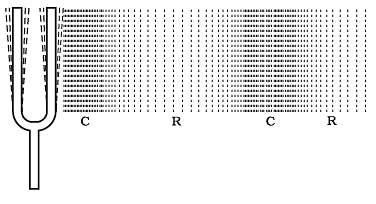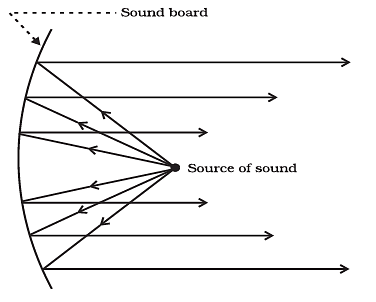Important Diagrams: Sound | Science Class 9 PDF Download
Q1: Answer the following questions based on the diagram given below:

(i) What is the purpose of using a tuning fork in this experiment?
Ans: The tuning fork is used to produce vibrations, which will help us understand how sound is produced and transmitted through a medium.
(ii) Describe the role of the suspended table tennis ball in this experiment.
Ans: The suspended table tennis ball is used to demonstrate how sound vibrations can affect nearby objects. It helps visualize the transfer of sound energy.
(iii) How does the tuning fork produce sound in this experiment?
Ans: When the tuning fork is struck, it vibrates rapidly. These vibrations produce sound waves, which travel through the air and cause the surrounding air molecules to vibrate, creating sound.
(iv) Explain the connection between vibration and sound production mentioned in the experiment.
Ans: Sound is produced when an object vibrates. In this experiment, the tuning fork's vibrations set the air molecules in motion, which results in the production of sound waves.
(v) What important principle about energy conservation can be observed from this experiment?
Ans: This experiment illustrates the principle of energy conservation, which means that energy cannot be created or destroyed. Instead, it is transformed from one form to another. In this case, mechanical energy from the tuning fork's vibrations is transformed into sound energy.
Q2: Answer the following questions based on the diagram given below:

(i) How does a vibrating object create sound waves in a medium?
Ans: A vibrating object creates sound waves in a medium by pushing and compressing the particles in front of it, forming compressions (C), and then moving backwards to create regions of low pressure known as rarefactions (R). This repeated process forms a series of compressions and rarefactions, which make up the sound wave.
(ii) What is a compression and a rarefaction in a sound wave?
Ans: A compression is a region of high pressure created in the medium when a vibrating object pushes and compresses the particles in front of it. A rarefaction is a region of low pressure formed when the vibrating object moves backward, creating a less dense area in the medium.
(iii) How are particles of the medium involved in the propagation of sound?
Ans: When an object vibrates, it displaces the particles of the medium around it from their equilibrium position. The displaced particles then exert forces on adjacent particles, setting them into motion. This process continues, transmitting the disturbance through the medium and creating a sound wave.
(iv) Why is air considered a common medium for sound propagation?
Ans: Air is a common medium for sound propagation because it allows particles to easily move and interact. When a vibrating object moves forward, it compresses the air in front, creating high-pressure regions (compressions), and when it moves backward, it creates low-pressure regions (rarefactions), which together form the sound wave.
(v) How are pressure and density related to the propagation of sound in a medium?
Ans: Pressure in a medium is related to the density of particles in a given volume. A higher density of particles results in higher pressure, and a lower density leads to lower pressure. Sound propagates through variations in pressure and density within the medium, forming compressions (high pressure) and rarefactions (low pressure) that constitute the sound wave.
Q3: Answer the following questions based on the diagram given below:

(i) What is the main characteristic of a sound wave that determines its pitch?
Ans: The frequency of a sound wave determines its pitch. Higher frequency corresponds to a higher pitch.
(ii) How is amplitude related to the loudness of a sound?
Ans: Amplitude is directly related to the loudness of a sound. Greater amplitude produces a louder sound.
(iii) Define wavelength of a sound wave.
Ans: Wavelength is the distance between two consecutive compressions or rarefactions. It's represented by the symbol λ (lambda) and is measured in meters (m).
(iv) Explain the term "compression" in relation to sound waves.
Ans: Compressions are regions of a sound wave with high density and high pressure. It's where the particles of the medium are pushed close together.
(v) What is the relationship between frequency and time period of a sound wave?
Ans: Frequency and time period of a sound wave are inversely related. Higher frequency means a shorter time period, and vice versa. The formula is: Frequency (ν) = 1 / Time period (T).
Q4: Answer the following questions based on the diagram given below:
(i) What is the principle of reflection of sound demonstrated in the activity using two pipes and a wall?
Ans: The principle of reflection of sound demonstrated in the activity is that sound waves bounce off a solid surface, just like how light reflects off a mirror, following the laws of reflection.
(ii) What are the two important aspects of the angles involved in the reflection of sound waves?
Ans: The two important aspects of the angles involved in the reflection of sound waves are:
- The angle of incidence: The angle at which the sound wave strikes the reflecting surface.
- The angle of reflection: The angle at which the sound wave is reflected from the surface.
(iii) How should the two pipes be positioned to best hear the sound of the clock placed near one of them?
Ans: To best hear the sound of the clock, the two pipes should be positioned so that they are at equal angles with respect to the normal (perpendicular line) to the wall. This means that the angle of incidence and the angle of reflection should be equal.
(iv) What happens when you lift the pipe on the right vertically to a small height during the experiment?
Ans: When you lift the pipe on the right vertically to a small height, it may disrupt the path of the sound waves and may reduce the intensity of the sound heard through the other pipe. This demonstrates that sound waves travel in straight lines and can be blocked or redirected by obstacles.
(v) Why is it necessary to have an obstacle of large size, which may be polished or rough, for the reflection of sound waves?
Ans: An obstacle of large size, whether polished or rough, is needed for the reflection of sound waves because sound waves have long wavelengths, and they interact with objects that are larger than the wavelength of sound. This allows for effective reflection, similar to how a mirror (smooth surface) or a wall (rough surface) can reflect light. Smaller objects are less effective at reflecting sound due to diffraction effects.
Q5: Answer the following questions based on the diagram given below:
(i) Explain the phenomenon of an echo using an example from daily life.
Ans: An echo is the sound we hear when a sound wave is reflected back to us from a suitable surface. For example, when we shout in a valley, the sound reflects off the mountains and comes back to us, creating an echo.
(ii) What conditions are necessary for hearing a distinct echo?
Ans: To hear a clear echo, there must be a time interval of at least 0.1 seconds between the original sound and the reflected sound. The minimum distance between the sound source and the reflecting surface should be half of the total distance traveled by the sound.
(iii) How does the speed of sound affect the distance required to hear an echo?
Ans: The speed of sound determines the total distance traveled by sound in a certain time. To hear a distinct echo, the total distance traveled by sound should be at least 34.4 meters (speed of sound × time).
(iv) Why does thunder produce echoes?
Ans: Thunder produces echoes because sound waves from the lightning strike reflect off multiple surfaces such as clouds and land, creating successive reflections that reach our ears as the rolling sound of thunder.
(v) How does air temperature affect the distance for hearing echoes?
Ans: Changes in air temperature can affect the speed of sound. Higher temperatures generally result in a higher speed of sound, altering the minimum distance required to hear an echo based on the updated speed of sound calculation.
Q6: Answer the following questions based on the diagram given below:


(i) What are some devices designed to send sound in a specific direction?
Ans: Megaphones, loudhailers, horns, trumpets, and shehanais are designed to send sound in a particular direction without spreading it in all directions.
(ii) How is sound spread evenly across the width of a hall in some situations?
Ans: A curved soundboard is placed behind the stage to reflect sound, ensuring it spreads evenly across the width of the hall.
(iii) What is the purpose of curved ceilings in concert halls, conference halls, and cinema halls?
Ans: Curved ceilings are designed to ensure that sound reaches all corners of the hall, helping to distribute sound evenly throughout the space.
(iv) How do musical instruments like trumpets utilize multiple reflections of sound?
Ans: Musical instruments like trumpets use their shape and design to focus and direct sound in a particular direction, utilizing multiple reflections to achieve this.
(v) In what way does a curved soundboard contribute to sound distribution in a hall?
Ans: A curved soundboard, when placed behind the stage, reflects sound, helping it to spread evenly across the width of the hall and ensuring better sound distribution.
|
88 videos|369 docs|67 tests
|
FAQs on Important Diagrams: Sound - Science Class 9
| 1. What is sound? |  |
| 2. How does sound travel through different mediums? |  |
| 3. What is the speed of sound in different mediums? |  |
| 4. How is sound produced and detected? |  |
| 5. What are the different properties of sound waves? |  |

|
Explore Courses for Class 9 exam
|

|

















